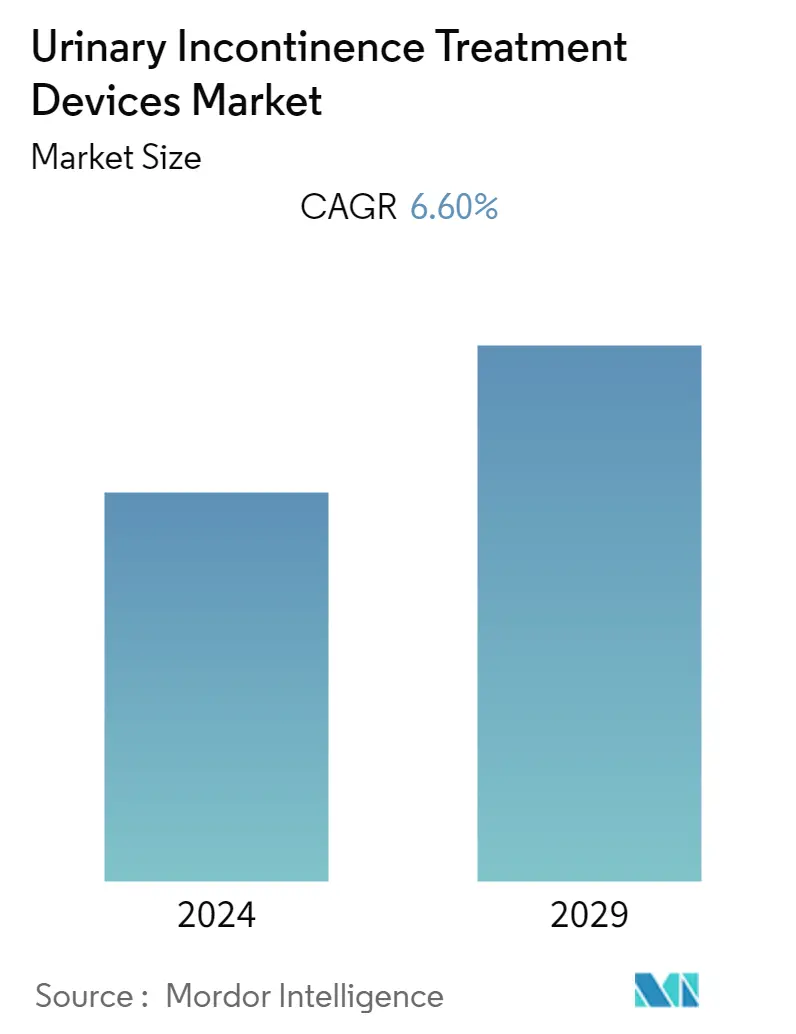Market Size of Urinary Incontinence Treatment Devices Industry

| Study Period | 2019 - 2029 |
| Base Year For Estimation | 2023 |
| Forecast Data Period | 2024 - 2029 |
| CAGR | 6.60 % |
| Fastest Growing Market | Asia-Pacific |
| Largest Market | North America |
Major Players
*Disclaimer: Major Players sorted in no particular order |
Need a report that reflects how COVID-19 has impacted this market and its growth?
Urinary Incontinence Treatment Devices Market Analysis
The urinary incontinence treatment devices market is expected to record a CAGR of 6.6% during the forecast period.
The COVID-19 pandemic significantly impacted the studied market, as there was an increased risk of urinary incontinence in COVID-19-infected patients. For instance, according to an article published by PubMed Central in February 2021, a study was conducted which showed that COVID19 infections cause inflammation and demyelination in the pudendal nerve, which ultimately leads to bladder incontinence. Thus, the COVID-19 pandemic significantly impacted the market initially, however as the pandemic has currently subsided, the studied market is expected to have stable growth during the forecast period of the study.
Factors such as the increasing prevalence of urinary incontinence and rise in the geriatric population and the rise in demand for minimally invasive surgery and product development are expected to boost the market growth.
The rising prevalence of urinary incontinence is one of the major factors driving the market growth. For instance, according to an article published by SpringerLink in March 2022, a study was conducted in Sweden which mentioned that urinary incontinence (UI) is defined as the complaint of involuntary loss of urine and has an estimated prevalence of about 25 to 45% among adult women. Thus, the high burden of urinary incontinence is expected to boost the adoption of urinary incontinence treatment devices.
Moreover, the rising geriatric population is another major factor driving the market growth, as urinary incontinence is much more common in elderly people. For instance, according to the World Population Prospects 2022 Report published by UN in 2022, it was estimated the share of the global population aged 65 years or above is projected to rise from 10% in 2022 to 16% in 2050. By 2050, the number of persons aged 65 years or over worldwide is projected to be more than twice the number of children under age 5 and about the same as the number of children under age 12. Thus, the rising geriatric population is expected to enhance the market growth.
Furthermore, the rising developments by major market players are also expected to boost market growth. For instance, in March 2022, Medtronic announced that its investigational implantable tibial neuromodulation (TNM) device has been implanted in the first patient for its TITAN 2 pivotal study. The multicentre, prospective study is designed to assess the device's safety and efficacy in people with urinary incontinence-related overactive bladder (OAB).
Thus, the aforementioned factors such as the rising prevalence of urinary continence coupled with the rising geriatric population, and the increasing developments by major market players are expected to boost the market growth. However, factors such as a lack of awareness about devices and social stigma associated with the disease, and the risks and complications related to the procedures, are expected to impede market growth over the forecast period.
